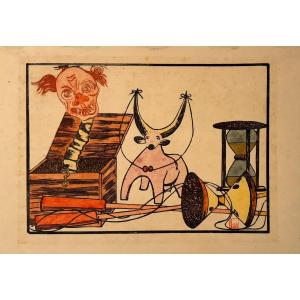To be compared to the Yosokukangu.
Proof bearing the artist's red stamp.
Some scattered foxing, slight oxidation when opening an old master key.
Before 1906
IFF: 19
"The first known engravings of Isaac, drypoints and aquatints in black and color, date back to 1900(...). The introduction of color, essential for Isaac since it already constituted a central question for his dyed fabrics, confirms his total immersion in Japanese art(...). The art that Alphonse Isaac practiced "with the most constancy and passion" was wood engraving in the Japanese style. He practiced it for around twenty years, from around 1905 until his death in 1924. The assimilation of the Japanese technique was the result of a long process, many years of study and experimentation. two engravings on alabaster, he made six engravings on wood of which only the blacks are printed, the colors still being applied with a brush. These undated engravings were undoubtedly made before 1906, two years before the lessons of a professional Japanese engraver. some time before the first dinner invitation from the Friends of Japanese Art. They represent Japanese toys accompanied by floral motifs. Deciphering these prints with unusual compositions is quite difficult because they remain unique in his work, even if they already include the main characteristics of Isaac's style, notably the taste for Japanese objects, the ornamental floral motif, the thick black line , the colors, used flat, finally the signature and sometimes the use of a small black swastika. This mark, which he borrows from Hokusaï and Totoya Hokkeï (1780-1850), accentuates the link with Japanese art and seems to mean “engraved and printed using Japanese processes”.
Émilie Vabre: News from printmaking, Prosper-Alphonse Isaac (1858-1924) Japanese-style wood engraver, 2011
Image width: 310.00
Image height: 217.00
Sheet width: 384.00
Sheet height: 267.00




























 Le Magazine de PROANTIC
Le Magazine de PROANTIC TRÉSORS Magazine
TRÉSORS Magazine Rivista Artiquariato
Rivista Artiquariato